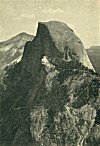
Sacred Texts Native American California Index Previous Next

It is but natural to suppose that the natives of the forests, surrounded as they were by naught but nature herself, unaided by, and untutored in, the mechanical and other arts of civilized man, knew no other and exercised no other guide in the construction of their places of abode than the dictates of common sense and the appliances at hand would suggest. Having no brick or mortar, no heavy well-cut timber for a pier, and no scantling for cross timbers, they drew upon mother earth for the foundation and upon the poles of the pine and cedar for scaffolding for the framework of their hut. They had no boards, either rough or smoothly planed, and the bark from the trees of the forest furnished the rustic cover for their ill constructed hut, or o-chum, as it was called.
These were built by taking a number of poles about twelve feet long, placing their ends in the ground around

Click to enlarge
HALF DOME (TI-SA-ACK)
Photo H. C. Tibbitts
an area about twelve feet in diameter, bringing them together at the top and lashing them with the thongs of the deer. The poles were then covered with slabs of cedar bark. A small hole was left at the bottom for an entrance, and another near the top for the escape of smoke. An ordinary sized o-chum, owing to the heat-reflecting power of its sloping walls, could be kept warm with very little fire, and was sufficient to house a family of six. In the summer they required but little shelter and their camps were made in the open, where a pile of brush placed on a scaffolding made of poles, or the boughs of a tree, sufficed to shelter them from the sun.
This was the Indian's castle--his palace; his luxuries were few indeed, and yet he was king of the forests and monarch of all he surveyed.